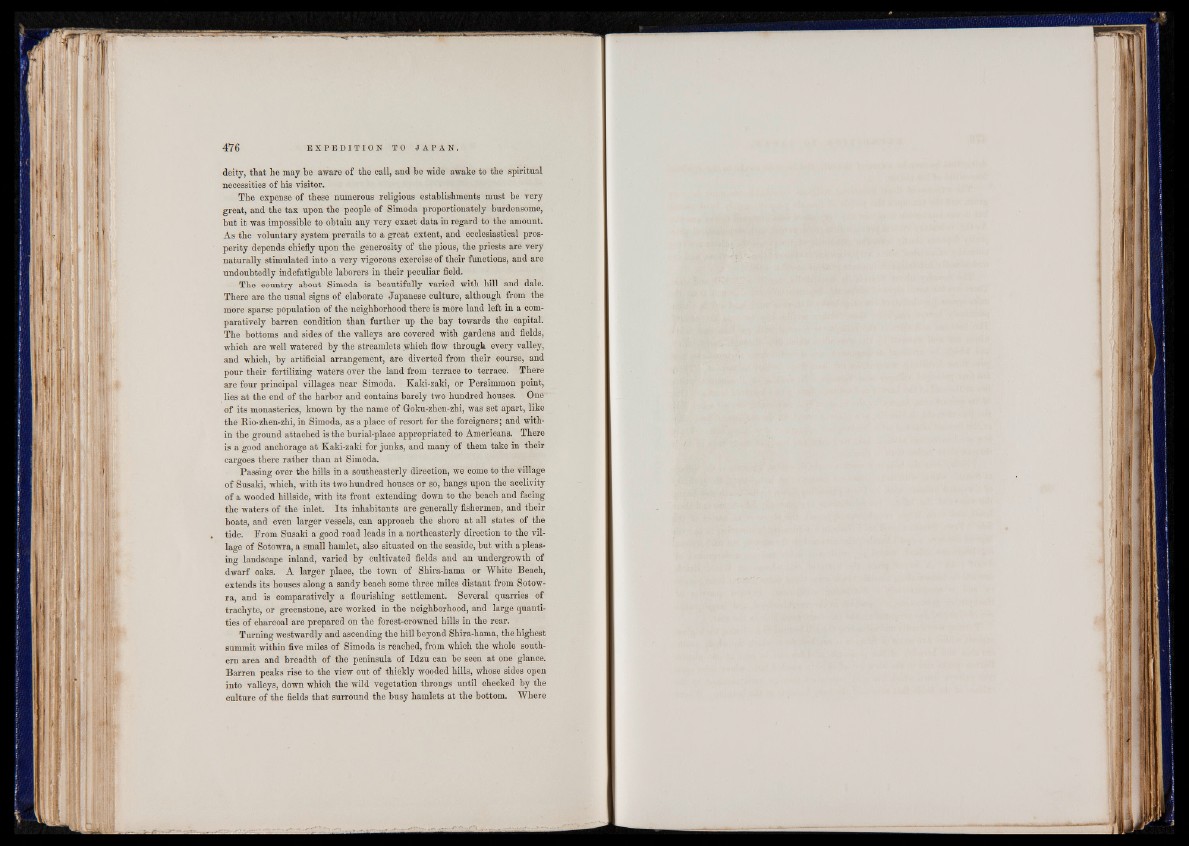
476 E X P E D I T I O N TO J A P A N .
deity, that he may be aware of the call, and he wide awake to the spiritual
necessities of his visitor.
The expense of these numerous religious establishments must be very
great, and the tax upon the people of Simoda proportionately burdensome,
hut it was impossible to obtain any very exact data in regard to the amount.
As the voluntary system prevails to a great extent, and ecclesiastical prosperity
depends chiefly upon the generosity of the pious, the priests are very
naturally stimulated into a very vigorous exercise of their functions, and are
undoubtedly indefatigable laborers in their peculiar field.
The country about Simoda is beautifully varied with hill and dale.
There are the usual signs of elaborate Japanese culture, although from the
more sparse population of the neighborhood there is more land left in a comparatively
barren condition than further up the bay towards the capital.
The bottoms and sides of the valleys are covered with gardens and fields,
which are well watered by the streamlets .which flow through every valley,
and which, by artificial arrangement, are diverted from their course, and
pour their fertilizing waters over the land from terrace to terrace. There
are four principal villages near Simoda. Kaki-zaki, or Persimmon point,
lies at the end of the harbor and contains barely two hundred houses. One
of its monasteries, known by the name of Goku-zhen-zhi, was set apart, like
the Rio-zhen-zhi, in Simoda, as a place of resort for the foreigners; and within
the ground attached is the burial-place appropriated to Americans. There
is a good anchorage at Kaki-zaki for junks, and many of them take in their
cargoes there rather than at Simoda.
Passing over the hills in a southeasterly direction, we come to the village
of Susaki, which, with its two hundred houses or so, hangs upon the acclivity
of a wooded hillside, with its front extending down to the beach and facing
the waters of the inlet. Its inhabitants are generally fishermen, and their
boats, and even larger vessels, can approach the shore at all states of the
tide. Prom Susaki a good road leads in a northeasterly direction to the village
of Sotowra, a small hamlet, also situated on the seaside, but with a pleasing
landscape inland, varied by cultivated fields and an undergrowth of
dwarf oaks. A larger place, the town of Shira-hama or White Beach,
extends its houses along a sandy beach some three miles distant from Sotowra,
and is comparatively a flourishing settlement. Several quarries of
trachyte, or greenstone, are worked in the neighborhood, and large quantities
of charcoal are prepared on the forest-crowned hills in the rear.
Turning westwardly and ascending the hill beyond Shira-hama, the highest
summit within five miles of Simoda is reached, from which the whole southern
area and breadth of the peninsula of Idzu can be seen at one glance.
Barren peaks rise to the view out of thickly wooded hills, whose sides open
into valleys, down which the wild vegetation throngs until checked by the
culture of the fields that surround the busy hamlets at the bottom. Where